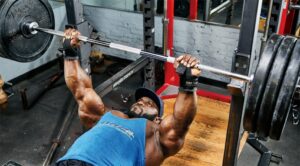The barbell bench press might feel like a simple exercise, especially if you’ve been training for a long time. There’s more to the movement than just laying on a bench and pushing weight off your chest though, especially considering what your goals are in the weight room. Legendary powerlifter Mark Bell demonstrates how he teaches the staple chest day exercise.
The bench press is an all-time great exercise to build chest size, but it’s also an important (ahem) benchmark strength movement, one of three events in the world of powerlifting competitions (along with the deadlift and barbell back squat). Working your way to pushing as much weight as possible isn’t just for growth if you’re a powerlifter. If you can’t get your bench up, you’re never going to compete.
So, some trainers might teach you how to bench press with a focus on hypertrophy to build as much muscle as possible. For others, like a legendary powerlifter and coach Mark Bell, who boasts a 578-pound raw bench press PR, the goal is to push weight. Bell recently shared a long YouTube tutorial about the exercise, really taking the time to break down what he believes are the most important aspects of the bench press. He’s teaching neuroscientist and podcaster Andrew Huberman, Ph.D. the move with an assist from coach Nsima Inyang—but if you’re interested on learning some more details about this school of thought, his tips will work for you, too.
How Mark Bell Teaches the Bench Press
For Bell, it all starts with the hand placement on the bar. He’s not set on one particular spot—it depends on what feels comfortable for the person doing the exercise. “Just make sure you have an even grip,” he says. Just make sure to squeeze the bar firmly. “When we squeeze a barbell, we want to squeeze it with everything that we’ve got because we’re trying to initiate from our fingers all the way down to our toes. We want everything to be involved in a bench press.”
Once you lay back on the bench, Bell stresses that it’s important that your chest is in an upright position to help maintain a neutral spine. “When our back is in a neutral position and our head is in a neutral position—it’s not too far down, it’s not too far up—we’re able to express the most amount of strength through our extremities, in this case our arms.”
When it comes time to move the weight, Bell has what sounds like a counterintuitive tip: pull the bar out of the rack, rather than pushing it. But there’s a method to the madness—pushing the weight out places your shoulders in a poor position once it comes time to get your body in position for the actual pressing. Especially if you’re working with a lot of weight, you’ll want to adjust yourself to get into pressing mode safely.
As you lower the weight to your chest, Bell advises to aim to a point near your sternum that feels comfortable. Protip: “If you’re working with a bigger belly, use that to shorten your range of motion to make it easier to complete the lift”.
From here, Bell rewinds a bit to talk about positioning on the bench. He acknowledges that there is a bit of a controversy around arching the back—but he quickly clarifies that dramatic stances that see athletes with their shoulders and butts as the only points of contact on the bench is not the goal here. “We’re not trying to arch the lower back,” he says. “We are arching aggressively though through the upper back and we are trying to take our shoulders and really screw them into the bench.” This concept is no different than other exercises like deadlifts and squats, in which you emphasize ‘screwing’ your feet into the ground in order to drive down to create power.
To get that arch, pull yourself down on the bench using the bar. Can’t figure it out? Have a spotter grab you by the traps to push you down into position. Just make sure that you don’t move your body as well an slide down the bench. Then, focus on activating your lower body by getting your feet on the ground. “I like to have my heels touching the ground,” says Bell. “Even if you’re someone that likes to be on your toes, you still want to drive your heels to the ground throughout the entire range of motion.” That’s because you want to be in a position where your knee is lower than your hip.
Next, Bell says that the key to your arm positioning is to have your bones stacked, with your wrist and fists overtop of your elbows, with your elbows close to the body. Keeping your arms close allow your to shorten your range of motion, again making the lift easier. You’ll also be able to use your lats and triceps to assist your chest from this position.
“At the bottom, if you kind of get it right, you’ll almost be able to feel like you can almost pull the weight into you and be really strong and explosive as you go to push back up,” he says. When you’re in that bottom spot, Bell recommends trying to “bend the bar”—sometimes, we at MH recommend trying to “break the bar”—by externally rotating your elbows. This allows you to create better leverage for your lift.
When Huberman takes over, Bell has some more comments on grip width. Just remember: “How you feel is much more important than an arbitrary position. Keep watching for more tips and hacks for even stronger benching”.








